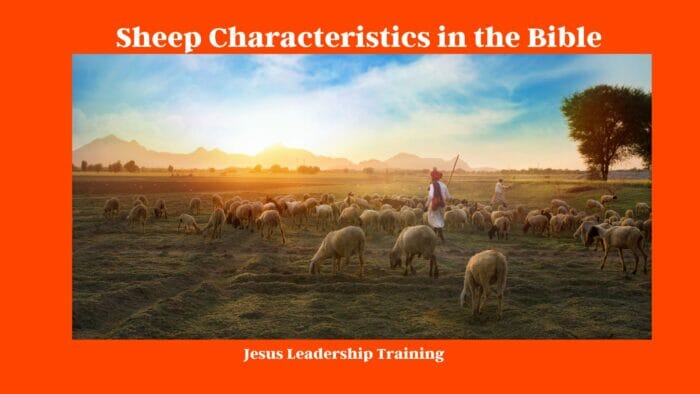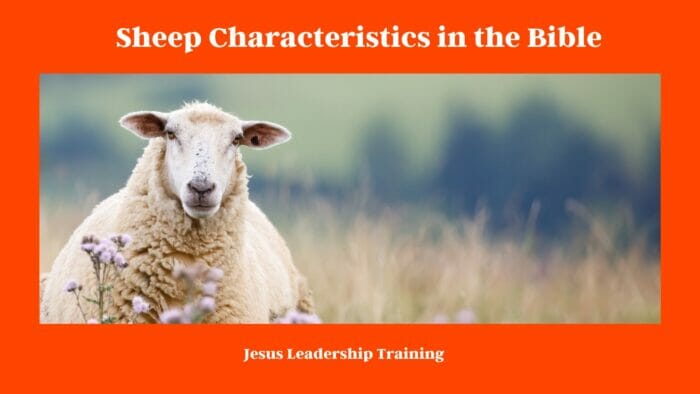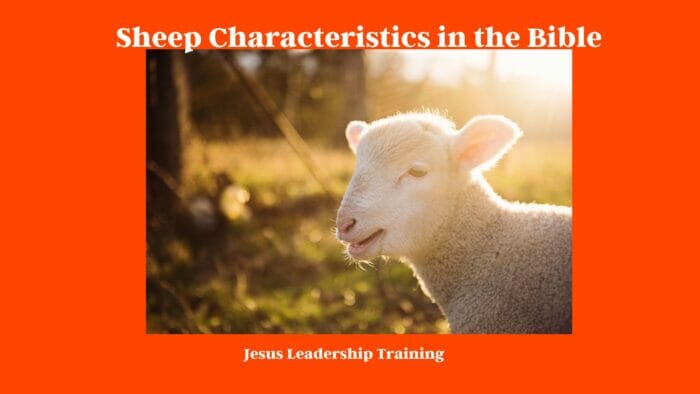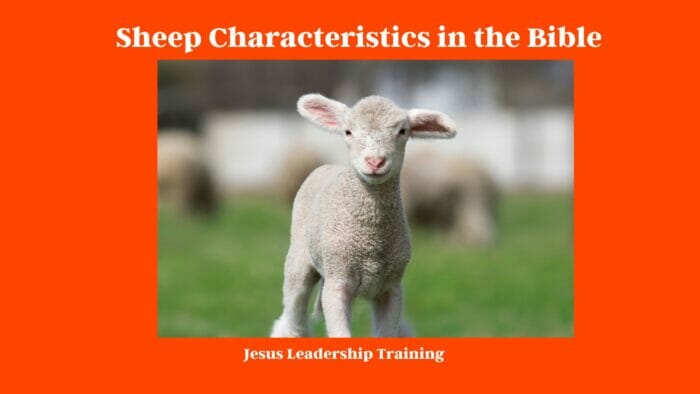Table of Contents
The Role of Sheep in Biblical Teachings
In the Bible, sheep are more than just simple animals. They have a rich symbolism that permeates the stories and teachings of Christianity. This article will explore the various sheep characteristics in the Bible, shedding light on their deeper meaning and significance in the context of biblical teachings. Prepare to embark on a journey of discovery and enlightenment.
Sheep Characteristics Bible: The Foundation
The Gentle and Innocent Nature of Sheep
Sheep are often seen as gentle and innocent creatures, which makes them the perfect symbol for purity and meekness in the Bible. Their docile demeanor represents the importance of humbleness and submission to God’s will.

Obedient Followers
Sheep are known to be obedient and follow their shepherd without question. This characteristic is often used as an analogy in the Bible to describe the relationship between Jesus and His followers, known as the “sheep of His pasture.
The Sacrificial Lamb
In biblical times, sheep were often used as sacrificial offerings to cleanse people of their sins. The lamb was a symbol of innocence, and its sacrifice represented the atonement for the sins of the believers. This sacrificial aspect of sheep is echoed in the story of Jesus, the “Lamb of God,” who was sacrificed for the salvation of humanity.
Sheep Serve as Spiritual Metaphors
here is a table that highlights some of the spiritual qualities often associated with sheep in biblical texts:
| Spiritual Quality | Description |
|---|---|
| Obedience | Sheep are known to follow their shepherd, and this is often used as a metaphor for spiritual obedience. Followers of Christ are called to obey God’s word (John 10:27). |
| Dependence | Sheep rely on their shepherd for protection and provision, symbolizing our dependence on God (Psalm 23:1). |
| Innocence | The white wool of a lamb often symbolizes purity and innocence in biblical texts. Christ’s followers are called to be innocent as lambs (Matthew 10:16). |
| Peacefulness | Sheep are generally peaceful animals, symbolizing tranquility and harmony. This reflects the peace of God that surpasses understanding (Philippians 4:7). |
| Sacrifice | Sheep were used for sacrificial purposes in the Old Testament. This foretold the ultimate sacrifice of Jesus, the “Lamb of God”, who was sacrificed for the sins of the world (John 1:29). |
| Community | Sheep are herd animals and feel safer in a flock. This symbolizes the importance of community and fellowship in Christianity (Hebrews 10:25). |

These qualities of sheep serve as spiritual metaphors, reminding us of God’s commands and His character.
Sheep in Parables and Teachings
The Lost Sheep
In one of Jesus’ most famous parables, He tells the story of a shepherd who leaves his ninety-nine sheep to search for the one that is lost. This parable illustrates the deep love and concern that God has for each of His followers, even when they stray from the path.
The Good Shepherd
Another well-known parable is the story of the Good Shepherd, who lays down his life for his sheep. This parable symbolizes the love and devotion that Jesus has for His followers, and His willingness to sacrifice Himself for their well-being.
Sheep and Goats
In the parable of the sheep and goats, Jesus separates His followers into two groups: those who are righteous (the sheep) and those who are wicked (the goats). This parable underscores the importance of living a life of compassion and mercy, as the sheep are rewarded for their kindness and the goats are punished for their selfishness.

Sheep Imagery in Psalms and Prophecies
Psalm 23: The Lord is My Shepherd
In this famous psalm, the writer expresses his trust and dependence on God as his shepherd. The imagery of a shepherd guiding and protecting his sheep represents the divine guidance and care that God offers to His followers.
The Suffering Servant
In the book of Isaiah, the prophet describes the coming Messiah as a suffering servant, who is “led like a lamb to the slaughter.” This imagery of a sacrificial lamb foreshadows the crucifixion of Jesus and emphasizes His role as the ultimate atonement for humanity’s sins.
here is a table that outlines the symbolism between sheep and Jesus in the Bible:
| Symbolism | Description |
|---|---|
| The Good Shepherd | In John 10:11, Jesus is described as the Good Shepherd who lays down his life for his sheep. This illustrates Jesus’ sacrificial love and care for his followers. |
| The Lamb of God | John the Baptist refers to Jesus as “The Lamb of God who takes away the sin of the world” (John 1:29). This refers to Jesus’ sacrificial death on the cross for the sins of humanity. |
| Lost Sheep | In the Parable of the Lost Sheep (Luke 15:3-7), Jesus likens God’s joy over a sinner who repents to a shepherd’s joy over finding a lost sheep. This emphasizes God’s grace and love for all, including those who stray. |
| Sheep among Wolves | Jesus sends out his disciples “as sheep in the midst of wolves” (Matthew 10:16). This illustrates the potential dangers and persecutions followers of Christ may face in the world. |
| Sheep and Goats Judgment | In the Parable of the Sheep and the Goats (Matthew 25:31-46), Jesus uses sheep to represent those who have served others in need, symbolizing righteousness. These “sheep” are placed on His right and welcomed into His kingdom. |
These examples reveal the rich symbolism between sheep and Jesus in biblical texts.
Things Sheep were Used for in the Bible
here’s a table of the various purposes that sheep served in the Bible:
| Purpose | Description |
|---|---|
| Sacrifice | Sheep were commonly used for sacrifices in the Old Testament. These sacrifices were made as a sin offering to atone for the people’s sins (Leviticus 4:32). |
| Wool Production | Sheep’s wool was a valuable resource, used for making clothing and other goods (Proverbs 31:13). |
| Food | Sheep were raised for their meat, providing sustenance for families and communities (Deuteronomy 14:4). |
| Milk Production | Sheep’s milk was consumed and also used to make cheese and other dairy products (Deuteronomy 32:14). |
| Religious Festivals | Sheep were slaughtered during religious feasts and celebrations, such as the Passover (Exodus 12:3-6). |
| Currency and Trade | Sheep were often used as a form of currency for trade. They were also given as gifts or offerings (Genesis 20:14). |
| Symbolism | In the Bible, sheep are frequently used as symbols. They often represent God’s people, with God or Jesus referred to as the shepherd. The sacrificial lamb is also a powerful symbol of Jesus’ sacrifice (John 10:11-15; Isaiah 53:7). |
Sheep were an integral part of life and worship in biblical times, and they continue to serve as powerful symbols in Christian theology.
The Bible Sheep Fold
The Biblical sheepfold, also referred to as a sheep pen or sheepfold, holds great significance in the context of biblical times and the cultural practices of shepherding. Found throughout the pages of the Bible, this structure served as a place of shelter and protection for sheep, ensuring their safety and well-being during the night or in times of danger. The sheepfold was an integral part of the lives of shepherds, who relied on it to safeguard their flocks.
In its simplest form, a sheepfold is an enclosure made of stone, wood, or a combination of both, with sturdy walls or fences that prevent the sheep from wandering off or being attacked by predators. The design of the sheepfold varied depending on the region and the available resources, but its primary purpose remained consistent across different cultures and time periods.
One common design of the sheepfold involved a circular or rectangular shape, often with a low wall made of stones or branches. This wall served as the primary barrier to keep the sheep within the fold and to fend off intruders.
In some cases, the wall would be reinforced with thorny branches or brambles to provide an additional layer of protection against predators. The height of the wall was typically low enough for the shepherd to easily see and count the sheep, as well as to enable the sheep to see one another, fostering a sense of safety and community within the flock.
The entrance to the sheepfold was a crucial element, typically positioned at one side of the enclosure. Unlike the walls, the entrance lacked a physical barrier, allowing the shepherd to guide the sheep in and out. However, to ensure the safety of the flock, the shepherd would often sleep or sit near the entrance, serving as the gatekeeper and protecting the sheep from any threats that may approach during the night.
This imagery is frequently referenced in the Bible, with Jesus Christ describing Himself as the “gate” or “door” of the sheepfold, emphasizing His role as the protector and provider for His followers.
The sheepfold not only provided protection but also had a symbolic meaning in biblical narratives. It represented the covenant relationship between God and His people, emphasizing His care, guidance, and watchful presence. Just as the shepherd guarded his flock,
God was portrayed as the ultimate Shepherd, leading His people, protecting them from harm, and guiding them to green pastures and still waters. This metaphorical significance deepened the understanding of God’s love, compassion, and faithfulness towards humanity.
In conclusion, the biblical sheepfold was a vital component of ancient shepherding practices, providing a safe haven for sheep and serving as a powerful symbol of protection and guidance. It exemplified the tender care of the shepherd and served as a metaphor for God’s relationship with His people, underscoring His role as the ultimate Shepherd and guardian.
The imagery of the sheepfold continues to resonate in biblical teachings, reminding individuals of the importance of seeking refuge and finding solace in the divine care and providence.
Qualities that a Good Shepherd has in the Bible
- Compassionate: A good shepherd is someone who shows compassion and care for their flock. In the Bible, Jesus is described as the “Good Shepherd” who “cares for his sheep” (John 10:11).
- Selfless: A good shepherd puts the needs of his or her flock before their own. Jesus says in the Bible, “The good shepherd lays down his life for the sheep” (John 10:11).
- Wise: A good shepherd is someone who is wise and can make good decisions for the benefit of their flock. In the Bible, Jesus is described as being “full of wisdom” (Proverbs 3:19).
- Faithful: A good shepherd is someone who is faithful to their flock. In the Bible, Jesus is described as being “the faithful Shepherd” (Psalm 23:1).
- Protective: A good shepherd is someone who is willing to protect their flock from harm. In the Bible, Jesus is described as being “the Good Shepherd who protects his sheep” (John 10:11).
- Supportive: A good shepherd is someone who provides support and guidance to their flock. In the Bible, Jesus says, “I am the Good Shepherd; I know my sheep and my sheep know me” (John 10:14).
- Trustworthy: A good shepherd is someone who can be trusted with the safety and wellbeing of their flock. In the Bible, Jesus is described as being “the Good Shepherd who can be trusted” (John 10:11).
- Patient: A good shepherd is someone who is patient and understanding of their flock. In the Bible, Jesus is described as being “slow to anger” (Psalm 103:8).
- Loving: A good shepherd is someone who loves their flock and shows them kindness. In the Bible, Jesus is described as the “Good Shepherd who loves his sheep” (John 10:11).
Characteristics of a Wolf in Sheep’s Clothing
here is a table that outlines the characteristics often associated with the phrase “a wolf in sheep’s clothing” based on biblical and broader cultural context:
| Characteristic | Description |
|---|---|
| Deceptive Appearance | A wolf in sheep’s clothing appears harmless, innocent, or trustworthy on the outside. This is a deceptive facade intended to mask their true nature or intentions. |
| Manipulative | These individuals often manipulate others for their own gain. They may use persuasive speech, emotional manipulation, or even spiritual language to convince others to trust them. |
| Self-serving | Wolves in sheep’s clothing often act primarily out of self-interest. Their actions and decisions are usually aimed at benefiting themselves, often at the expense of others. |
| Destructive | Like a wolf among sheep, these individuals can cause harm or disruption in communities. This could involve spreading rumors, causing divisions, or leading people away from the truth. |
| Hidden Motives | These individuals often have hidden agendas. Their true intentions may not align with what they outwardly express or promise. |
| Untrustworthy | Despite their outward appearance, wolves in sheep’s clothing are ultimately not trustworthy. They can betray confidences or fail to uphold commitments. |
The phrase “a wolf in sheep’s clothing” originates from the Bible (Matthew 7:15), where Jesus warns his followers to beware of false prophets who appear harmless but are inwardly dangerous.
FAQs on Sheep Characteristics in the Bible
- What is the significance of sheep in the Bible?Sheep hold a significant role in the Bible due to their various symbolic meanings, including innocence, purity, humility, and sacrifice. They are also used in numerous parables and teachings to illustrate important spiritual lessons.
- Why are Jesus’ followers called “sheep”?Jesus’ followers are called “sheep” because they are meant to be obedient and submissive to His teachings, just as sheep follow their shepherd without question.
- **What is themeaning behind the “Lamb of God”?**
The term “Lamb of God” refers to Jesus Christ, who is seen as the ultimate sacrificial lamb. His crucifixion and death served as an atonement for humanity’s sins, making Him the perfect symbol of sacrifice and redemption.
- How does the parable of the lost sheep demonstrate God’s love for His followers?The parable of the lost sheep illustrates God’s immense love and concern for each of His followers, even when they stray from the path. It shows that He is willing to go to great lengths to bring them back to the fold, emphasizing the depth of His love and compassion.
- What is the message behind the parable of the sheep and goats?The parable of the sheep and goats teaches the importance of living a life of compassion, mercy, and selflessness. It emphasizes that our actions and how we treat others have a direct impact on our eternal destiny, with the righteous being rewarded and the wicked being punished.
- How is the imagery of a shepherd used in the Bible?The imagery of a shepherd is used in the Bible to represent God’s guidance, protection, and care for His followers. As a shepherd leads and cares for his sheep, God leads and cares for those who trust in Him.
Final Thoughts – The Enduring Symbolism of Sheep in the Bible
The sheep characteristics in the Bible hold a powerful and profound symbolism that resonates throughout the teachings and stories of Christianity. From their innocent and gentle nature to their role as sacrificial lambs, sheep serve as a constant reminder of the importance of humility, obedience, and selflessness in our spiritual journey. By understanding and appreciating the deeper meanings behind these symbols, we can gain a richer and more profound understanding of the Bible’s teachings and apply them to our own lives.



